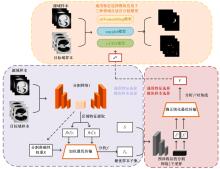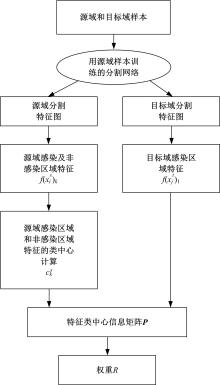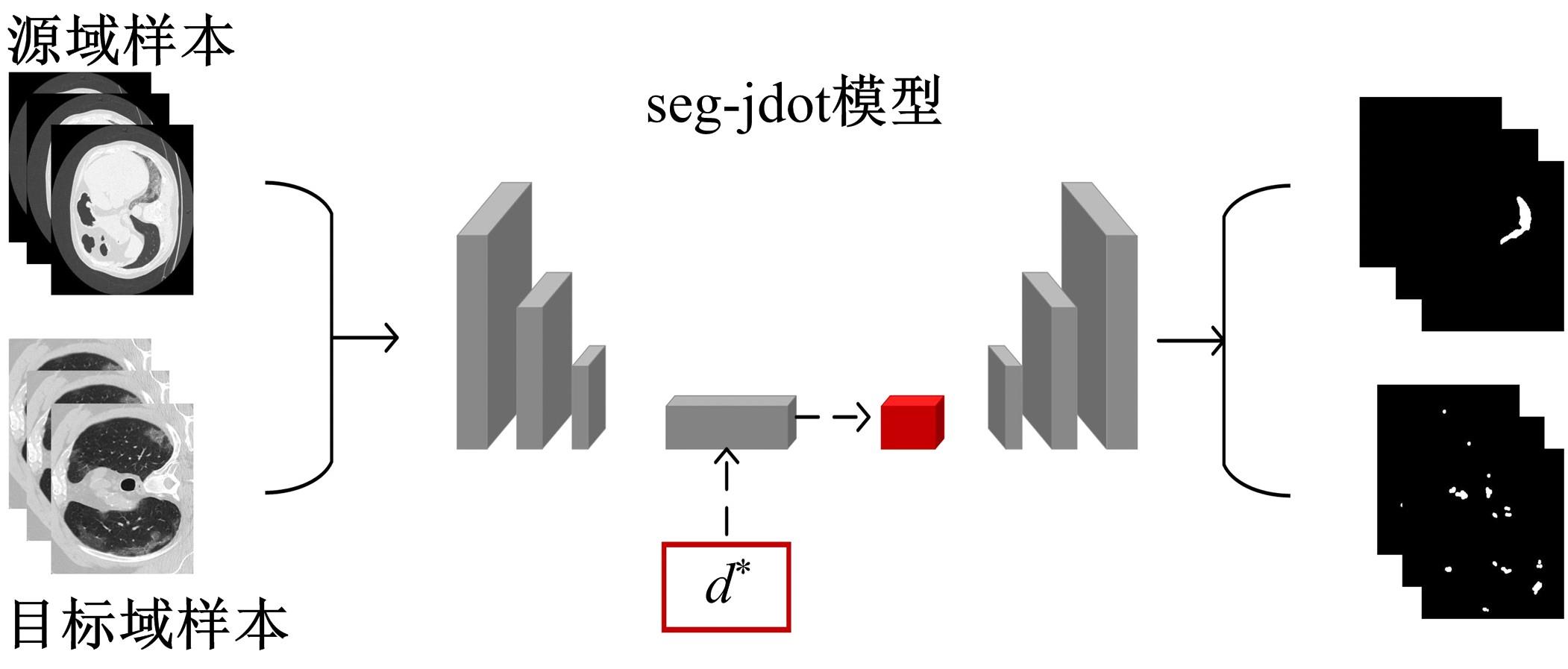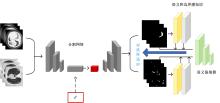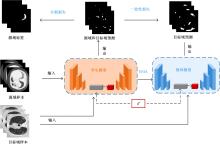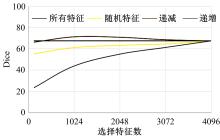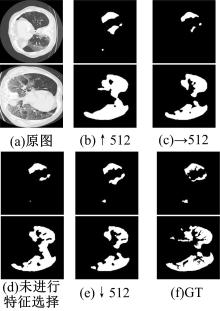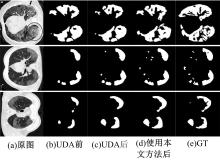Journal of Jilin University(Engineering and Technology Edition) ›› 2022, Vol. 52 ›› Issue (7): 1626-1638.doi: 10.13229/j.cnki.jdxbgxb20210652
Transfer learning of medical image segmentation based on optimal transport feature selection
Sheng-sheng WANG1( ),Lin-yan JIANG1,Yong-bo YANG2
),Lin-yan JIANG1,Yong-bo YANG2
- 1.College of Computer Science and Technology,Jilin University,Changchun 130012,China
2.Teaching Assessment Center,Air Force Aviation University,Changchun 130021,China
CLC Number:
- TP18
| 1 | Huang J, Smola A J, Gretton A, et al.Correcting sample selection bias by unlabeled data[J]. Advances in Neural Information Processing Systems, 2007, 19: 601-608. |
| 2 | Ganin Y, Ustinova E, Ajakan H, et al. Domain-adversarial training of neural networks[J]. Advances in Computer Vision and Pattern Recognition, 2017, 17(1): 2096-2130. |
| 3 | 许新征, 丁世飞, 史忠植,等. 图像分割的新理论和新方法[J]. 电子学报, 2010, 38(): 76-82. |
| Xu Xin-zheng, Ding Shi-fei, Shi Zhong-zhi, et al. New theories and methods of image segmentation[J]. Acta Electronica Sinica, 2010, 38(Sup.): 76-82. | |
| 4 | He B S, Zhu F, Shi Y G. Medical image segmentation[J]. Advanced Materials Research, 2013, 760-762(4): 1590-1593. |
| 5 | Courty N, Flamary R, Tuia D, et al. Optimal transport for domain adaptation[J]. IEEE Transactions on Pattern Analysis and Machine Intelligence, 2017, 39(9): 1853-1865. |
| 6 | Courty N, Flamary R, Habrard A, et al. Joint distribution optimal transportation for domain adaptation[J]. Advances in Neural Information Processing Systems, 2017, 30: 3731-3740. |
| 7 | Tzeng E, Hoffman J, Zhang N, et al. Deep domain confusion: maximizing for domain invariance[J/OL]. [2021-06-10]. |
| 8 | Ruan C, Wang W, Hu H, et al. Category-level adversaries for semantic domain adaptation[J]. IEEE Access, 2019, 7: 83198-83208. |
| 9 | Hoffman J, Tzeng E, Park T, et al. CyCADA: cycle-consistent adversarial domain adaptation[C]∥The 35th International Conference on Machine Learning, Stockholm, Sweden, 2018: 3162-3174. |
| 10 | Dou Q, Ouyang C, Chen C, et al. Unsupervised cross-modality domain adaptation of convnets for biomedical image segmentations with adversarial loss[C]∥Proceedings of the Twenty-Seventh International Joint Conference on Artificial Intelligence, New York, USA, 2018: 691-697. |
| 11 | Redko I, Habrard A, Sebban M. Theoretical analysis of domain adaptation with optimal transport[C]∥Joint European Conference on Machine Learning and Knowledge Discovery in Databases, London, England, 2017: 737-753. |
| 12 | Balaji Y, Chellappa R, Feizi S. Normalized wasserstein for mixture distributions with applications in adversarial learning and domain adaptation[C]∥Proceedings of the IEEE International Conference on Computer Vision, Seoul, South Korea, 2019: 6509-6517. |
| 13 | Damodaran B B, Kellenberger B, Flamary R, et al. DeepJDOT: Deep joint distribution optimal transport for unsupervised domain adaptation[C]∥Proceedings of the European Conference on Computer Vision (ECCV), New York, USA, 2018: 447-463. |
| 14 | Ackaouy A, Courty N, Vallée E, et al. Unsupervised domain adaptation with optimal transport in multi-site segmentation of multiple sclerosis lesions from MRI data[J]. Frontiers in Computational Neuroscience, 2020, 14: 19. |
| 15 | Xu R, Liu P, Wang L,et al. Reliable weighted optimal transport for unsupervised domain adaptation[C]∥Proceedings of the Conference on Computer Vision and Pattern Recognition, Seattle, USA, 2020: 4394-4403. |
| 16 | Li M, Zhai Y M, Luo Y W, et al. Enhanced transport distance for unsupervised domain adaptation[C]∥Proceedings of the Conference on Computer Vision and Pattern Recognition, Seattle, USA, 2020: 13936-13944. |
| 17 | Li J, Zhao J, Lu K. Joint feature selection and structure preservation for domain adaptation[C]∥Proceedings of the Twenty-Fifth International Joint Conference on Artificial Intelligence, New York, USA, 2016: 1697-1703. |
| 18 | Sun F, Wu H, Luo Z, et al. Informative feature selection for domain adaptation[J]. IEEE Access, 2019, 7: 142551-142563. |
| 19 | Gautheron L, Redko I, Lartizien C. Feature selection for unsupervised domain adaptation using optimal transport[C]∥Joint European Conference on Machine Learning and Knowledge Discovery in Databases, London, England, 2018: 759-776. |
| 20 | Villani C. Optimal transport old and new[J]. Springer Science & Business Media, 2007, 338(23/24): 480-488. |
| 21 | Cuturi M. Sinkhorn distances: lightspeed computation of optimal transport[C]∥Neural Information Processing Systems, Lake Tahoe, Spain, 2013: 2292-2300. |
| 22 | Knight P A. The Sinkhorn-knopp algorithm: convergence and applications[J]. SIAM Journal on Matrix Analysis and Applications, 2008, 30(1): 261-275. |
| 23 | Li H, Loehr T, Sekuboyina A, et al. e-UDA: efficient unsupervised domain adaptation for cross-site medical image segmentation[J/OL]. [2021-6-10]. . |
| 24 | Perone C S, Ballester P, Barros R C, et al. Unsupervised domain adaptation for medical imaging segmentation with self-ensembling[J]. NeuroImage, 2019, 194: 1-11. |
| 25 | Laradji I, Rodriguez P, Manas O, et al. A weakly supervised consistency-based learning method for COVID-19 segmentation in CT images[C]∥Proceedings of the IEEE/CVF Winter Conference on Applications of Computer Vision, New York, USA, 2021: 2453-2462. |
| 26 | Zhou T, Canu S, Ruan S. An automatic COVID-19 CT segmentation network using spatial and channel attention mechanism[J]. International Journal of Imaging Systems and Technology, 2020, 21(1): 16-27. |
| 27 | Simonyan K, Zisserman A. Very deep convolutional networks for large-scale image recognition[C]∥International Conference on Learning Representations, New York, USA, 2015: 1-14. |
| [1] | Hao-yu TIAN,Xin MA,Yi-bin LI. Skeleton-based abnormal gait recognition: a survey [J]. Journal of Jilin University(Engineering and Technology Edition), 2022, 52(4): 725-737. |
| [2] | Xue-zhi WANG,Qing-liang LI,Wen-hui LI. Spatio⁃temporal model of soil moisture prediction integrated with transfer learning [J]. Journal of Jilin University(Engineering and Technology Edition), 2022, 52(3): 675-683. |
| [3] | Xue WANG,Zhan-shan LI,Ying-da LYU. Medical image segmentation based on multi⁃scale context⁃aware and semantic adaptor [J]. Journal of Jilin University(Engineering and Technology Edition), 2022, 52(3): 640-647. |
| [4] | Yong LIU,Lei XU,Chu-han ZHANG. Deep reinforcement learning model for text games [J]. Journal of Jilin University(Engineering and Technology Edition), 2022, 52(3): 666-674. |
| [5] | Jing-pei LEI,Dan-tong OUYANG,Li-ming ZHANG. Relation domain and range completion method based on knowledge graph embedding [J]. Journal of Jilin University(Engineering and Technology Edition), 2022, 52(1): 154-161. |
| [6] | Zhi-hua LI,Ye-chao ZHANG,Guo-hua ZHAN. Realtime mosaic and visualization of 3D underwater acoustic seabed topography [J]. Journal of Jilin University(Engineering and Technology Edition), 2022, 52(1): 180-186. |
| [7] | Song-mei TANG. Key technology of face recognition system based on swarm intelligence in library [J]. Journal of Jilin University(Engineering and Technology Edition), 2021, 51(6): 2216-2224. |
| [8] | Yan-lei XU,Run HE,Yu-ting ZHAI,Bin ZHAO,Chen-xiao LI. Weed identification method based on deep transfer learning in field natural environment [J]. Journal of Jilin University(Engineering and Technology Edition), 2021, 51(6): 2304-2312. |
| [9] | Sheng-sheng WANG,Jing-yu CHEN,Yi-nan LU. COVID⁃19 chest CT image segmentation based on federated learning and blockchain [J]. Journal of Jilin University(Engineering and Technology Edition), 2021, 51(6): 2164-2173. |
| [10] | Yong YANG,Qiang CHEN,Fu-heng QU,Jun-jie LIU,Lei ZHANG. SP⁃k⁃means-+ algorithm based on simulated partition [J]. Journal of Jilin University(Engineering and Technology Edition), 2021, 51(5): 1808-1816. |
| [11] | Ya-hui ZHAO,Fei-yang YANG,Zhen-guo ZHANG,Rong-yi CUI. Korean text structure discovery based on reinforcement learning and attention mechanism [J]. Journal of Jilin University(Engineering and Technology Edition), 2021, 51(4): 1387-1395. |
| [12] | Jing-bin LI,Yu-kun YANG,Bao-qin WEN,Za KAN,Wen SUN,Shuo YANG. Method of extraction of navigation path of post-autumn residual film recovery based on stubble detection [J]. Journal of Jilin University(Engineering and Technology Edition), 2021, 51(4): 1528-1539. |
| [13] | Yan-hua DONG,Jing-wei LIU,Jing-hua ZHAO,Liang LI,Fang-xi XIE. Real-time torque tracking control based on BPNN online learning prediction model [J]. Journal of Jilin University(Engineering and Technology Edition), 2021, 51(4): 1405-1413. |
| [14] | Fu LIU,Yi-xin LIANG,Tao HOU,Yang SONG,Bing KANG,Yun LIU. Improvement of fuzzy c-harmonic mean algorithm on unbalanced data [J]. Journal of Jilin University(Engineering and Technology Edition), 2021, 51(4): 1447-1453. |
| [15] | Fu-hua SHANG,Mao-jun CAO,Cai-zhi WANG. Local outlier data mining based on artificial intelligence technology [J]. Journal of Jilin University(Engineering and Technology Edition), 2021, 51(2): 692-696. |
|
||
